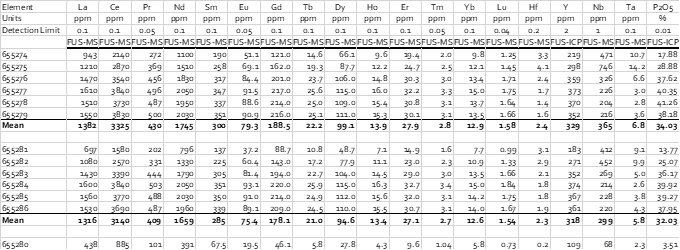TORONTO, ON / ACCESSWIRE / May 6, 2021 / Nuinsco Resources Limited ("Nuinsco" or "the Company") (CSE:NWI) today reported that metallurgical testing has demonstrated the potential to significantly upgrade the neodymium grade in concentrate, along with other rare earth elements ("REE"s), at its 100%-owned Prairie Lake project.
Neodymium ("Nd") is an element vital in the global conversion to renewable energy and electric vehicle manufacture. Over the past 12 years Nd has ranged in price from a low of US15.47/kg in 2009 to a high of US$251.74 in 2010; it currently trades at US$66.10/kg, an increase of US$17.06/kg over the past year¹. In addition to numerous other high-value REEs (see table below) as well as phosphate, these metallurgical findings increase the Company's optimism for the economics of Prairie Lake. The enrichment in Neodymium is significant because of the anticipated increase in demand for this element to meet requirements for the expanding electrification of the world's vehicle fleet and conversion to renewable energy sources.
New analyses were conducted on a suite of samples obtained from a historic metallurgical program conducted by the Company using gravity pre-concentration and flotation processes to evaluate the potential to produce a high-grade phosphate (P2O5) concentrate from Prairie Lake raw phosrock (carbonatite - see table below); as such the tests were optimized for phosphate recovery. The tests demonstrate the feasibility to upgrade raw Prairie Lake phosrock from circa 3.5% P2O5 to >30% P2O5 (34.03% and 32.03% in the case of the mean grade from the two tests reported here²). It is important to note that P2O5 is a vital non-renewable resource essential for sustaining the life of plants and animals.
While the phosphate grade was clearly enhanced in the metallurgical test by a factor of nearly 10 the REE content was also substantially increased. Although the tests were not optimized to REE recovery the concentrates produced still showed a substantial upgrade in REE concentration. In the case of neodymium (Nd), raw phosrock in the Prairie Lake carbonatite contains an average of 350 ppm Nd, while the average grade of the concentrates reported here are 1745 ppm Nd and 1659 ppm Nd - a concentration factor of approximately 4.5. Similar concentration factors are observed for other rare earth elements.
"The Prairie Lake project has the potential to create products that span a range of markets," said Paul Jones, CEO. "The ability to produce a high-grade P2O5 concentrate from the Prairie Lake phosrock is a significant project milestone in itself; the added presence of by-product or co-product REEs cannot be overstated. The metallurgical results from Prairie Lake, coupled with the large scope of the project (refer to the technical report dated November 30, 2018 and filed on SEDAR), the excellent logistics, increased market demand for REEs, and supply chain and jurisdictional security make the project a very desirable asset. Additional sampling of Prairie Lake drill core will be conducted to continue to add detail to our understanding of the mineralization at the project."
Amongst the REEs, Nd is particularly valued because of the critical importance of Nd-based permanent magnets in the manufacture of a range of new technological products including the high-performance electric motors and generators used in, for example, hybrid-electric vehicles and megawatt-scale wind turbines. However Nd is but one of the high-value minerals at Prairie Lake. Demand for REEs, as well as niobium, tantalum and phosphate, is projected to continue to rise as their use in a host of applications in the automotive, high-tech, clean-energy, telecommunication and global agriculture industries expands.
Prairie Lake consists of forty-six mineral claims covering an area of 630 ha which are superbly located, with ready access to power, road, rail and shipping infrastructure; it is easily accessed by an all-weather road from the TransCanada Highway, 28 kilometres to the south. The mineralization identified is entirely contained within the Prairie Lake carbonatite complex.

¹Source: www.statista.com
² The rare earth elements, niobium, tantalum and P2O5 determinations reported here are from two metallurgical tests conducted by COREM in Quebec City, Quebec from a series of tests constituting a metallurgical program conducted on Prairie Lake carbonatite between 2009 and 2012. The results were produced from a metallurgical program designed to optimize P2O5 recovery using gravity pre-concentration followed by flotation; the tabulated results show recovery at six grind-size distributions for each metallurgical test. The mean grades reported for each test are the average grade of the analytical results for each of the six separate grind sizes. Sample 655280 is the raw, unprocessed, carbonatite phosrock. The analyses were generated by Activation Laboratories, Ancaster, Ontario using the analytical methods identified in the table and submitted to the laboratory under the 8REE analysis code with XRF option for Nb and Ta. Elements analyzed are La - Lanthanum, Ce - Cesium, Pr - Praesodymium. Nd - Neodymium, Sm - Samarium, Eu - Europium, Gd - Gadolinium, Tb - Terbium, Dy - Dysprosium, Ho - Holmium, Er - Erbium, Tm - Thulium, Yb - Ytterbium, Lu - Lutetium, Hf - Hafnium, Y - Yttrium, Nb - Niobium, Ta - Tantalum. P2O5 is the oxide of phosphorus.
L.A. Giroux, P.Geo., is a qualified person as defined by NI 43-101 and has reviewed and approved the technical contents of this press release regarding the Prairie Lake project.